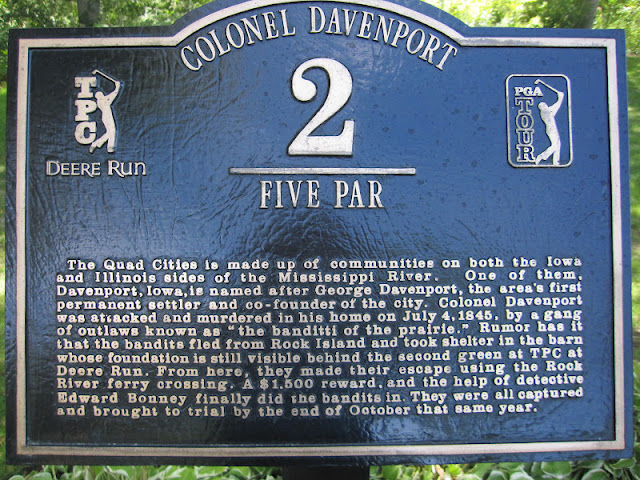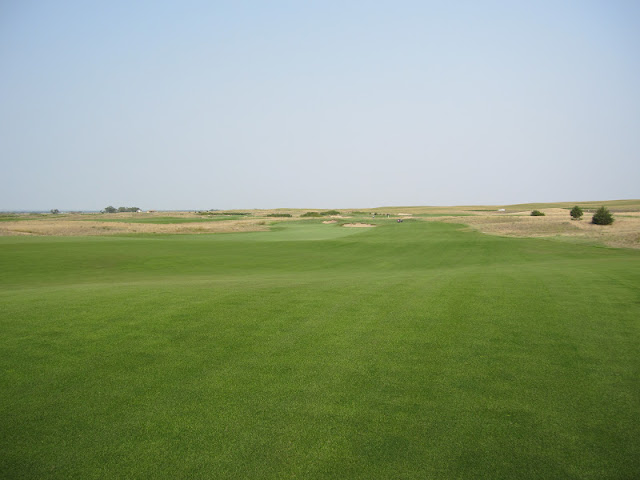You might think that I would have already played the states closest in proximity to my home, but that was not the case. My original target in Illinois was the Medinah Country Club in Chicago, which may have been possible if I had tried to get on earlier in the year. Medinah is hosting the 2012 Ryder Cup in September, an event that was already consuming their attention in early July when I started to arrange a tee time. Attempts to contact them through the Crow Valley pro went unanswered, so I moved down the list to TPC at Deere Run. One other reason to play Deere Run was one of my retirement gifts was a gift certificate that had been gathering dust for the past year - - - it was time to use it. Playing Deere Run was not a difficult task; it is open to the public. I arranged a tee time within 24-hours of play, and it was a short 17-mile drive from my home.
Deere Run is situated on a piece of property with a history that includes Native American settlements, farming, coal mining, and most recently – one of the top horse and cattle breeding programs in the country. A man named Erskine Wilson built a stone house and farm on this land at the very same time a man living 70-miles upstream named John Deere was starting a plow company. Participants in the course design felt that it was important for every visitor to understand the historical significance of this piece of ground – and so they named each hole on the course after the land’s rich heritage.
157-yard par 3 hole #3
Erskine Wilson's stone house (now serves as the office for the JD Classic tournament director)
One such piece of history is told on a plaque beside the hole #2 tee box, appropriately named “Colonel Davenport”. Davenport, one of the Quad Cities on the Iowa side of the Mississippi River, is named after the area’s first permanent settler, George Davenport. Colonel Davenport was attacked and murdered in his home on July 4, 1865 by a group of bandits. Rumor has it the bandits fled from Rock Island and took shelter in the barn whose foundation is still visible behind the hole #2 green. From here they made their escape using the Rock River ferry crossing. They were all captured and brought to trial by October that same year.
501-yard par 5 hole #2
Hole #2 (view from the fairway of one of the old farm buildings situated behind the green)
For more than 40-years, William & Patricia Hewitt owned the property that Deere Run sits on. The property served as one of the top Arabian horse-breeding operations in the country under the name Friendship Farm. Patricia Hewitt was the great, great, granddaughter of John Deere. William Hewitt served as the Chairman and Chief Executive Officer of Deere & Company from 1955 to 1982, a period of time when the Company grew into its prominent position as the #1 supplier of farm equipment globally. A lone oak tree in the middle of the hole #4 fairway is now known as “Hewitt Tree”. It recognizes the Hewitt family’s good stewardship of the property - - - a constant reminder for any golfer facing the oak tree obstacle as they prepare to tee off on the hole named “Friendship Farm”.
417-yard par 4 hole #4 (Hewitt Tree is sitting in the middle of the fairway in front of the distant sand trap)
Hole #4 (view from the rough looking out over the green at the Rock River below the bluff)
Designed by D.A. Weibring, TPC Deere Run preserved the natural, rolling landscape along the Rock River to create a championship golf course beautifully framed by oak trees and accented by small ponds & deep ravines. Deere Run has hosted the PGA Tour’s John Deere Classic tournament since 2000. The course is recognized by Golf Digest as #82 on America’s 100 Greatest Public golf courses and at #13 on the Best-in-State Ranking for Illinois.
The clubhouse at Deere Run
Round: #47
Location: Silvis, IL
Golf Digest Best-In-State Rank: #13
Date: 18 Aug, tee off at 12:27 PM
Conditions: sunny, 6 MPH wind, 77 degrees
Yardage: 6,426
Lost balls: 1
Score: 85 on a par 71
My playing partner was my son, Jack. He is the Supply Chain Controller at HNI Corporation, the 2nd largest manufacturer of office furniture in the world and the leading manufacturer & marketer of fireplaces in the USA. With a 45-minute commute to his job in Muscatine, Iowa he does not find much time to play golf by comparison to his retired father. That is a good thing since he can hit the ball much farther than me. I need to play often to maintain a slight advantage in the short game (chipping & putting). He was also at a disadvantage going into our round with very little warm-up time. We were quite surprised to arrive at a course with a great practice range while being provided with a bag of 15-balls for our use. Perhaps it was someone’s dumb idea for saving the club some expense as it is customary to have unlimited range balls for use at any of the better rated courses I have played.
Jack
Our practice time on the putting green was cut also short when the starter prodded us into moving onto the nearby #1 tee box to start the round. In any event, my short game advantage started to show up immediately after making par putts on 3 of the first 4 holes while Jack started the round with a string of bogeys. I was maintaining a 2-stroke going into hole #9 where he made par and I shot a double bogey. We were tied at 42 going into the turn.
359-yard par 4 hole #1
Hole #1 (view of approach shot to the green from the fairway)
411-yard par 4 hole #5
Hole #5 (view of approach shot to the green from the fairway)
332-yard par 4 hole #6
185-yard par 3 hole #7
Jack quickly gave me the lead again on the par 5 hole #10 when his 2nd shot found the green side bunker which gave him problems getting out and onto the green. I landed on the green in regulation and 2-putted for a par; his double bogey returned the match to a 2-stroke advantage for the Old Man! After playing even up over the next 3-holes, he erased my lead again with back-to-back pars on hole #14 and #15 where I could do no better than a pair of bogeys. We were tied again after 15-holes of play.
512-yard par 5 hole #10
Hole #10 (view of the green from the fairway - bunkers on left, pond on right)
178-yard par 3 hole #12
The last few holes have been the determining factor in determining a winner of the John Deere Classic in each of the last 2-years. Perhaps it was destiny, but the same challenges would also determine the outcome of our friendly father-son competition. I gained an advantage with a par on the short par 3 hole #16 to return to 1-up after he bogeyed the hole. We both made par on #17 with 1-hole remaining in our match.
127-yard par 3 hole #16
Hole #16 (view of the green looking out over the Rock River)
490-yard par 5 hole #17 (view of approach shot to the green from the fairway)
Both of us found the fairway with our drives on hole #18, he out-drove me as expected. My approach shot failed to reach the green, but it was good enough to insure a victory after his ball hit the bank and bounced into the pond. A mere 1-2’ to the right on Jack’s approach shot would have likely enabled him to make par and tie the match as I finished the hole with a bogey.
One last insight into Deere Run’s history is in the name given to the 18th hole: “Conquistador”. A plaque beside the tee box contains the following inscription:
The Spanish word conquistador means “one who conquers”. This has special meaning here on the 18th hole. The foaling barn for Friendship Farm used to sit on the ridge that overlooks the right side of the fairway. It was here where the farm’s internationally recognized Arabian horses were born and took their first steps. One of the Farm’s prize breeding horses was named Llano Grande Conquistador. He sired countless prize-winning offspring throughout the years. Tournament participants of the PGA Tour’s John Deere Classic contested every year at the TPC at Deere Run have to walk over the same ground as Llano Grande Conquistador to lay claim to the same title - CHAMPION.
428-yard par 4 hole #18
Hole #18 (view of the green from the right side of the fairway)
Hole #18 (view from the green looking back up the fairway)
Jack & Jim on the 18th green
Instead of a foaling barn, the clubhouse at Deere Run now sits atop the ridge above the 18th fairway. The grassy knoll underneath the stately oak trees was set up for a wedding ceremony that evening. Tests of the sound system provided the music of Kenny G while we were completing our round of golf. The music and wedding preparations brought back memories of 2005 - when we attended Jack & Heather’s wedding reception on the same ridge.
Wedding on the ridge at Deere Run: August 18, 2012
Jack & Heather's wedding reception on the ridge at Deere Run: June 11, 2005



























































